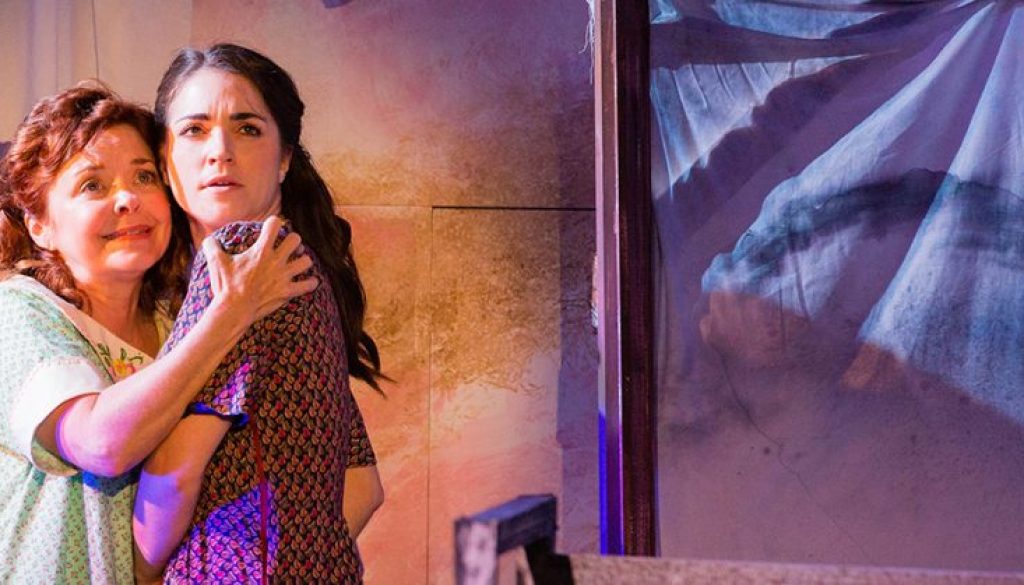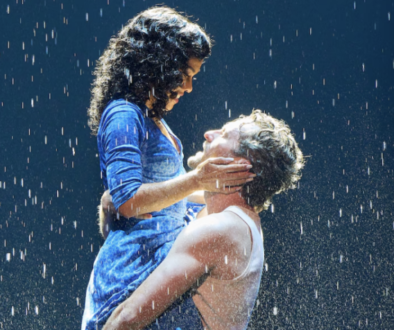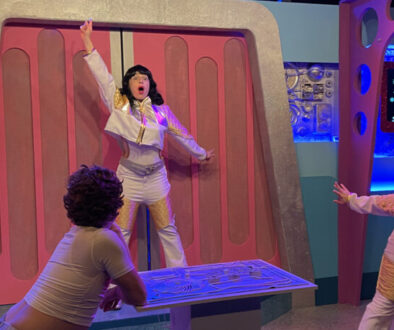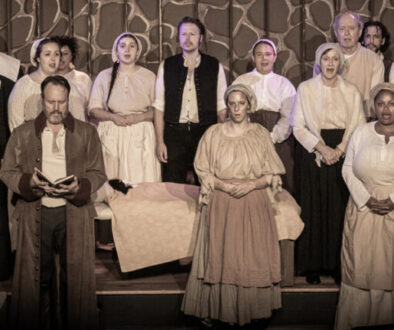By ALAN SMASON, WYES-TV Theatre Critic (“Steppin’ Out“)
There is little doubt when Thomas Lanier Williams put pen to paper and drafted what became The Glass Menagerie that he was pouring out the poetic words that traced his own tortuous upbringing. Under the guise of his nom de plume, Tennessee Williams, his “memory play” was a very convenient device, indeed. It permitted him the opportunity to reveal the nature of the narrator of Tom Wingfield as a character not unlike himself, a brilliant, but troubled iconoclast with a wandering soul.

While the central characters of Amanda and Laura Wingfield are the active players on the stage and about whom most of the action devolves, the character of Tom is the glue that holds the work together. He acts as both narrator – it is, after all, his memory we are seeing – and, occasionally with the wisdom of time, as a modern counterpart to that of a Greek chorus in a tragedy.
As co-artistic directors of the Tennessee Williams Theatre Company of New Orleans, Augustin Correro and Nick Shackelford have amassed an impressive number of outstanding works by their namesake playwright over the last four years. Correro, as the director of these works, has always given theatre-goers something that is both carefully considered and thoughtful.
Their Season Five opener of The Glass Menagerie is currently running at the Marigny Opera House and is no less imbued with a talented cast and worthy production values than their previous award-winning offerings.

As Amanda, Judy Lea Steele gives an ebullient and memorable performance as the domineering matriarch of the family. She is reproachful in her manner toward her disappointing children and is quick to tell anyone who listens how much she sacrificed in her ill-advised nuptials to a now-missing telephone man “who fell in love with long distance.”
Steele wears the badge of martyrdom well as she extols her daughter Laura (Julia DeLois) in lessons she has learned from life, most especially how to attract gentlemen callers as she did when she was a young, eligible lady. While many previous portrayals of Laura have emphasized her frailty and extreme shyness, DeLois, through Correro’s direction, shows a much stronger and somewhat refreshing side to her character. A limp that is normally part of Laura’s character on stage is very much downplayed or ignored entirely, for example.
Williams’ scholars are quick to point out that the playwright’s own sister Rose was a troubled lass who suffered from schizophrenia and depression that left her placed in sanitariums for most of her life. She was given to overly sexualized behavior because of her mental illness and Williams was also troubled by his sister’s eventual lobotomy, enforced by their stern mother Edwina, who sought to impose her indomitable will on all her offspring.

These recurrent themes of Rose’s behavior which he first explores in The Glass Menagerie for Laura Wingfield are echoed in several of Williams’ later plays such as Vieux Carré and Summer and Smoke, which deal with concepts like lobotomies and sexual acting out in the face of strong matriarchal figures. While Laura is seen as a delicate and timid figure, the playwright clearly indicates she is of sound mind. Therefore, for Laura to be compared to Rose in all but a general sense, would not be entirely accurate.
The scenes with Amanda and Laura are perhaps the most engaging. Steele beautifully captures the formidable will of the mother as she moves from her own fantasized past to that of dealing with the exigencies of life in a downtrodden St. Louis neighborhood. She tries to engage her socially disconnected daughter, while exploiting the industry of her wayward son.
The connection between Laura and her gentleman caller Jim O’Connor (Matthew Raetz) is established early in the play, but the two do not meet until Act Two. DeLois skillfully plays Laura as a girl with a crush who is hopeful the two can establish a relationship. It is the last desperate move by which she might be rescued from a life filled with little hope and great uncertainty.
Raetz plays his scenes well as Jim and is particularly good in revelatory scenes with Laura and also with Nathaniel Twarog, who plays Tom.

So it is that we return to the character of Tom Wingfield and the choices employed by Twarog in defining that role in this production. As many Williams’ scholars will concur, the playwright was by his own description a poet first and it is in his poetry wherein are found the words that cause his characters to resonate with charm.
Twarog rushes the playwright’s words for Tom in such a way that the subtleties of his performance are oftentimes lost. The words are as written on the page, but the spacing between the words seems off at times and his character thus suffers from a diminishment of the expected poetry of the playwright. At times this feeling of speeding up Tom’s lines works well to realize some of the comedy the playwright intended. But those moments are fleeting and few.

Again, as a character who is central to the play’s narrative, it is important to the appreciation of what lies within the acts of The Glass Menagerie that Tom be understood and that he connects to the other characters in a meaningful fashion. We may not like what he does, but we do need to recognize the motivations behind his actions and the full scope of his character’s development. The audience would have been served better were Tom’s scenes with his mother and sister accented more with the phrasing that suggested they had actual history together.
That connection between characters shows up better in Tom’s scenes with Jim, the stranger he brings to his home and to whom he confides a terrible secret. It may be that Tom, like Tennessee in real life, enjoys a better rapport with men than the women in his life. At any rate, Twarog might have turned a good performance into one that was even more memorable by slowing down his patois and allowing the measured words of the playwright to convey more of an emotional connection.
Scenic design is by Joey Santhoff and is good, although somewhat spartan in the vast space of the Marigny Opera House. Wispy white curtains are used to denote the room of the family’s crowded apartment effectively. Co-artistic director Nick Shackelford’s sound design is every bit as good as ever heard on a local stage and perfectly complements the action on stage. The lighting by Diane K. Baas is also very good for this specific performing space.
Directed by Augustin J. Correro, The Glass Menagerie by Tennessee Williams finishes its run with performances tonight, Thursday, August 15 as well as Friday and Saturday, August 16-17 at 7:30 p.m. at the Marigny Opera House, 725 St. Ferdinand Street. Tickets are $31.00 each and can be purchased here or by calling 504-264-2580





